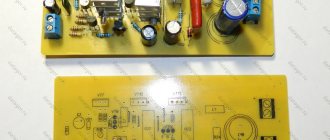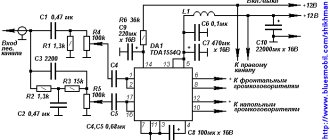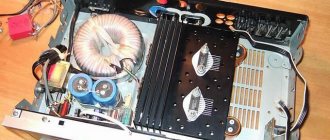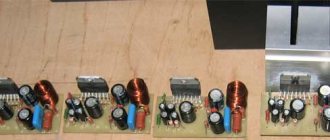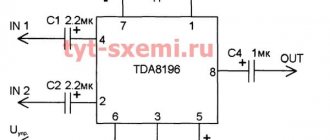Judging by the characteristics in the datasheet from ST Microelectronics, the TDA7293 is a single-channel class AB audio amplifier. This chip is used in HI-Fi equipment for sound amplification: home music centers, including self-powered ones, TVs, etc. Thanks to a wide voltage range and high output currents, it is capable of providing good power (up to 100 W) in a load of 4 or 8 Ohm.
This microcircuit has the following functions: suppression of noise at the output when turned on/off (No switch on/off noise), attenuation of the output signal up to 80 dB (Mute), sleep mode (Stand-By), clip detector (Clip detector). To amplify very weak signals, multiple devices can be connected in parallel. Equipped with built-in protection against short circuit, overheating and static discharge.
Unfortunately, especially recently, there are counterfeits of the semiconductor device in question on the Russian market. Therefore, many radio amateurs have a negative attitude towards it. However, the low price (from 200 to 400 rubles) and good sound quality have made it a massive and popular solution even in modern household acoustics. There are already ready-made amplifier modules on sale, assembled on the basis of tda7293 according to standard switching circuits.
Tsokolevka
The TDA7293 is manufactured in a MULTIWATT15 plastic package, which has 15 pins. It comes in two versions: for vertical (MULTIWATT15V) or horizontal (MULTIWATT15H) installation on the board. The substrate has a physical connection to the eighth leg (minus). The purpose of each of the pins of the microcircuit is shown in the figure below.
Due to the fact that the TDA7293 has a “minus” on the substrate, installation on a radiator is allowed only through a mica gasket with thermal paste. Otherwise, the short circuit current will damage the chip.
Specifications
The TDA7293 amplifier provides low levels of noise and distortion at the output. According to the technical description (datasheet), with its help you can achieve a maximum sound power of 100 W, with a load (RL) of 8 Ohms and a maximum supply voltage (VS) of ± 40 V. With such parameters, you get a clean 50-60 W or more, if Several devices are connected in parallel. Total harmonic distortion (THD) does not exceed 10%. This is due to the presence of built-in field-effect transistors in the preliminary and output amplification stages of this microcircuit.
Maximum values
Here are the maximum characteristics of the TDA7293:
- maximum supply voltage VS (in the absence of a signal) ± 60 V;
- pulse current at output IO = 10 A;
- power dissipation (at Tcase = 70 OS) Ptot = 50 W;
- operating temperature range from 0 to 70 °C;
- temperature: crystal Tj up to +150 °C; when stored up to +150 °C.
These are the maximum parameter values. Exceeding any of them may damage the device. At the same time, the power dissipation is limited by the temperature of the case, so the larger the radiator, the better.
Analogs
The only and closest analogue of the microcircuit in question is the TDA7294. From the technical characteristics it is known that the TDA7293 has a higher supply voltage and power dissipation. Therefore, when replacing, you need to be careful and make sure that the effective values do not exceed the maximum for the TDA7294. For example, the supply voltage should not exceed 40 V. In addition, the TDA7294 does not have voltage booster or clip detector functions. However, there is a widespread belief among radio amateurs that the TDA7294 is more reliable and less buggy.
Connection schemes
The TDA7293's sufficiently large supply voltage range allows it to be used to design amplifiers with power from 20 to 100 W. The main switching circuits are discussed in the article about the TDA7294, to which it is very similar. At the same time, numerous experiments with this device make it possible to create more advanced acoustics on it.
The video discusses the tda7293 and the circuit of a universal amplifier with inverting and non-inverting connections. The use of a potentiometer provides the ability to smoothly adjust the current using voltage. This solution significantly improves the sound quality of the system as a whole, especially with the use of full-range speakers.
Parallel connection
As mentioned earlier, the TDA7293 allows parallel connection of two microcircuits (the circuit is in the datasheet). It allows you to increase the current in the acoustic load and achieve an output power of 100-120 W. With this connection, one of the devices operates in master mode, and the other in slave mode. Only the output stage, which receives an amplified signal from the master, will work on the slave.
Parallel connection is recommended only for high-power circuits (up to ± 40 V) with a low-impedance load of 4 or 8 ohms. In a similar way, it is possible to connect even more than two microcircuits, where one will act as a master and the rest as a slave. But such a solution is considered impractical, since the supply voltage will need to be increased (a good power supply is needed), and the increase in output power at the circuit output will be insignificant.
In addition, in such schemes it is desirable to provide for a phased switching on of each of the slaves after approximately 1-2 seconds, in order to mitigate possible consequences after applying voltage to the master. The fact is that at the moment power appears at the outputs of each of the microcircuits, a signal surge is formed, which can damage slave devices connected to them and operating in slave mode. The delay can be organized using additional timers and control relays.
When connected in parallel, it is desirable that all microcircuits be from the same manufacturer, preferably from the same batch. It is worth considering that with an increase in their number in the resulting output stage, sound distortion will inevitably increase. These problems, the need to use a powerful power supply, as well as the complexity of the amplification circuit, make this solution unpopular among radio amateurs.
Bitter experience of buying TDA7293 chips
Those who create home audio or assemble amplifiers themselves have probably come across a description of the ST TDA7293 microcircuits. If you haven’t seen it, be sure to look for it and read it. Using these fairly simple chips you can build a very high-end amplifier. I build such an amplifier into a wall niche, install hidden wiring and built-in acoustics. This allows you to avoid unnecessary wires in the room, speakers in the corners and the installation of a mandatory shelf or bedside table under the TV. I originally ordered a 5.1 amplifier board but, unfortunately, its design and circuitry turned out to be poor. All amplifier channels were driven by long wires, and the board layout was terrible. Trying to somehow correct this Chinese craft, many modifications were made. During one of them, I mixed up the plus and minus of the power supply, and all the TDA7293 microcircuits burned out with pops resembling firecrackers. After that, I changed the approach to modularity and used a proven scheme and ordered printed circuit boards for it, wired independently, to the dimensions I needed. Of course, I also ordered parts along with the boards, including TDA7293 chips.
Realizing that there was a high risk of running into a fake, I looked for the distinctive features of genuine ST microcircuits. It turns out that to verify authenticity, it is enough to measure the resistance between the metal eye (positive wire) and pins 5, 10 and 11 (negative wire of the tester). For genuine microcircuits, the resistance should be about 3 megohms. In the opposite polarity of the tester, the measured resistance should be infinite. Having received my first order from a fairly large store with a high rating, I realized that I received a fake. However, the fake was well designed and differed little in appearance from the original. The second order from another large and trusted store turned out to be just as fake. Moreover, in the received microcircuits, not a single pin except the 8th and lug was ringing. The rest showed endless resistance in any direction. The third and fourth orders turned out to be crude fakes in appearance, but some of the outputs were ringing, although not as they should be for the original microcircuits. At this point, I had already assembled a test board with a socket for TDA7293:
With certain precautions, I tested the entire accumulated stock. As you would expect, none of the microcircuits worked:
Now I'm waiting for two more orders, and I want to share my experience on how to distinguish a fake TDA7293 from a real one.
In Chinese stores, the TDA7293 chip (or its counterfeit) costs less than two dollars. So why counterfeit such a cheap product? It’s simple, our Chinese colleagues have learned to do it en masse, inexpensively and from almost nothing. Nothing personal. It's just their business.
It all started with the release of TDA7293 and TDA7294. The latter have slightly less functionality and worse power characteristics. So the first fake TDA7293 were relabeled TDA7294. The pinout of the microcircuits is almost the same and in most cases the relabeled TDA7294 worked quite successfully instead of the TDA7293. Except that sometimes they accidentally burned out. But then our beloved Shaolin became completely insolent. Any microcircuits in Multiwatt15 packages were relabeled. And hundreds of varieties of these were produced. So, apparently they are purchased in huge quantities from Chinese garbage dumps or warehouses of illiquid goods. But what about other names, since they are laser engraved? It's simple: the cases are polished, grinding off the names along with the plastic. This is where the first and most important difference between the original and the fake arises. Take a closer look at the photo, on the left is the original (burnt out) microcircuit, and all the others are relabeled:
Grinding changes the surface of the chip body. It becomes smoother than the original, this is done to hide scratches from abrasive during grinding. Therefore, if you see that the side surfaces of the plastic of the microcircuit differ in texture from the front side, this is 100% fake. In addition, when polished, stamped circles with numbers are completely erased or become less noticeable. Their absence or the absence of numbers in them is the second sure sign of a fake. But the Chinese went further in their forgery skills. After grinding, the microcircuit housings were treated with a sandblasting tool. This gives the body a certain texture reminiscent of the original casting. The second chip from the left is made exactly like this:
But sandblasting does not spare the stamps on the body; they also form a texture, which is not present on the original.
The inscription on the polished cases is applied using a laser engraver similar to the original one, so it is not easy to distinguish it. But probably. The company ST Microelectronics, which created the ST TDA7293, stamps its logo in a prominent place in the middle:
Therefore, if you see the ST logo in the corner of the case or it is missing altogether, this is a guaranteed fake:
But even if the inscription is in the middle, this is not a guarantee of authenticity. First of all, look at the surface of the case. By the way, on original microcircuits the metal ear is covered with a uniform matte layer of metal, and in counterfeit ones there are traces of galvanizing that resemble stains or traces of grinding, apparently to give junk counterfeits a marketable appearance.
And lastly: laser engraving on original microcircuits and fakes is different. On fakes, the inscriptions are made in slightly thinner lines. Perhaps the laser power of the crooks is not the same as at the factory. And take a closer look (when lighting allows) at the color of the inscription. On fakes it may be slightly yellowish. The reason is that a homemade laser engraver melts the plastic and thereby creates a yellowish mark. The most interesting thing is that after washing such an inscription with an organic solvent (for example, Galosh gasoline), it becomes colorless. I hope the Chinese don't read this text
It is also possible to measure the thickness of the case and almost certainly for fakes it will be smaller due to grinding. Read about it in the second part of the review.
Be careful not to fall for fakes! Always open a dispute and never withdraw it in exchange for a promise to send you something else in return. This is the only way to protect yourself from losing money. No one will compensate you for your lost time. Therefore, I hope what is stated here will help you.
UPD
for questions in the comments: All 28 (twenty-eight) microcircuits ordered on E-bay and Aliexpress (that is, 100% of the number ordered) turned out to be counterfeit and completely non-functional. They did not make calls using the specified method, did not work (or warmed up, but did not work) in the test board. I checked everything 10 times.
E-bay and Aliexpress returned money for all open disputes. As proof, I published photographs of measurements with a resistance tester between the 5th or 11th pin and the metal eye. For the very first order (I took two pieces to try) on Ebay, I did not receive money, because I did not know how to check the authenticity, and missed the time to open a dispute.
Chinese sellers have very funny answers in disputes. Here is an example of the seller’s “argumentation” in the last dispute I won on Aliexpress: Hi! Sir The goods are in transit! You can wait for time! You cancel the dispute! I can extend the receipt time for you!Add 15 days! Thank you! You can cancel the dispute!Thank you very much!
Of course, there is no need to answer this, much less swear. It is necessary to calmly remind the essence of the complaint and ask whether there is anything to answer on the merits.
Another very interesting point: Have you noticed that in the description of goods (in particular microcircuits and other equipment) there is a field: “Brand name” (manufacturer’s name). If not, please note that sellers NEVER indicate the original brand. For example, here instead of ST or ST Microelectronics, CazenOveyi is indicated. According to Aliexpress rules, this is enough to accuse the seller of counterfeiting. After all, you receive a chip with the ST logo, but you ordered CazenOveyi. And also, if the seller erases or blurs the manufacturer’s logo in the photo, expect a fake. Brazen or cunning, but wait...
I have not yet found (did not receive) original ST TDA7293 microcircuits on Ebay and Aliexpress. Perhaps they exist, I’ll give an example: After the second order and dispute, I wrote a detailed review to the seller on E-bay with photos of the tests. Of course, he didn’t like this, but he honestly admitted that he doesn’t understand the authenticity of microcircuits, but simply sells them. He promised to send me new ones to replace them so that I would withdraw the review. But he deceived me and didn’t send anything. The most interesting thing is that after this the lot with TDA7293 for two dollars was removed from sale, and after some time the same lot with TDA7293 appeared, but for seven dollars. Apparently, this is how much the real ones cost to purchase them, or the seller decided to insure himself with a protective price.
Chip and Dip is really a way out, but since I ordered a lot of things from the package on Ebay and Aliexpress, I didn’t pay attention to the store “nearby”. If two of the ordered batches are fake while on the way, then I’ll go shopping at Chip and Dip. To be fair, it should be noted that some items from local sellers are taken from China, but cost two prices.
PS I apologize for the quality of the photos, but there is no equipment for macro photography. I tried my best: I waited for the sun, laid out the microcircuits on white paper (so that there would be no problems with balance) and spent a long time selecting an angle and choosing from the received photos.
PPS For those interested, I took the information about checking authenticity by dialing from here. Of course, only a test board can give a 100% guarantee. In my case, the test results with the tester and on the board coincided completely.
PPPS The tested circuit is taken from here. And this is what the boards on which the microcircuits were tested look like:
Unfortunately, no errors were found in the boards. Of course, I checked everything with an oscilloscope. And even with a test radiator (to avoid pops and smoke). Resistor R6 was soldered off to ensure unmute. The track from the 12th leg of the TDA7293 is cut to allow testing of the TDA7294 (jumper on the back of the board).
If anything, 10 more such boards have been assembled:
Waiting in the wings (genuine TDA7293)
Regarding “fakes” or “replicas”. Let’s say that replicas (that is, fully or partially functional copies) of original ST TDA7293 microcircuits are produced in China. You can't set up microchip production in a garage. It must be a large factory with multi-million dollar equipment and large staff. Most chip manufacturing equipment is not manufactured in China. It (the equipment) is supplied by well-known companies under well-known contract conditions. Of course, the obligation not to print crystals in violation of copyright is one of the points of delivery of such equipment. You, as an individual, will not be sold machines for printing money. And states buy them. But suppose there is chaos in China. And the Chinese, having bought (or copied) American or European production lines, began to print whatever they wanted. And they called it “replicas.” But since these microcircuits are printed at the factory, why would they then erase the names from the cases and engrave new ones? Therefore, the existence of “replicas” is possible, but I don’t really believe in such a story. She's not logical. Imagine yourself in the shoes of a factory owner: you have service contracts for many, many millions, and you, at the risk of termination of contracts and loss of money, will churn out (even hundreds of thousands) microcircuits for one dollar. A very risky and dangerous business. It's easier to print money. Fakes can also be called “replicas”. :))
Therefore, everything in sawn casings must be called by its proper name: fake or counterfeit. In Aliexpress terminology this is “counterfeit”.
Good luck and attention!


